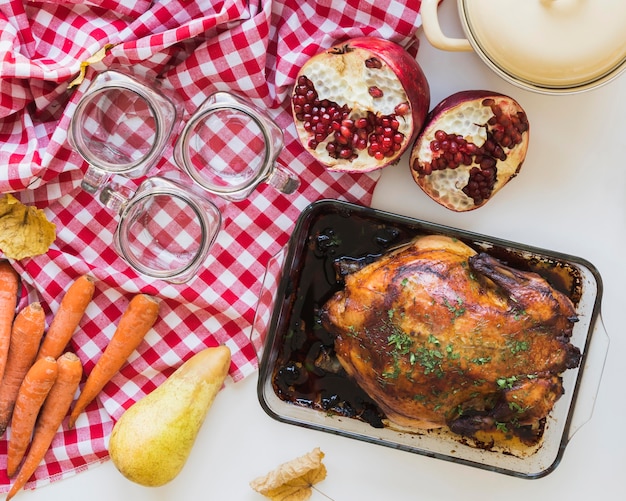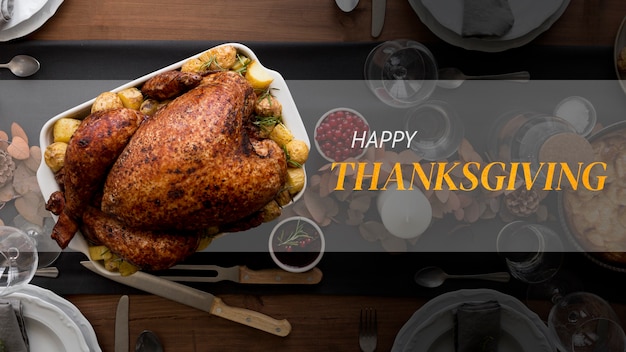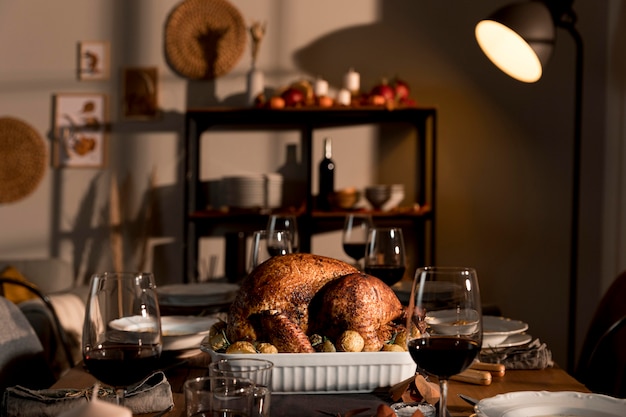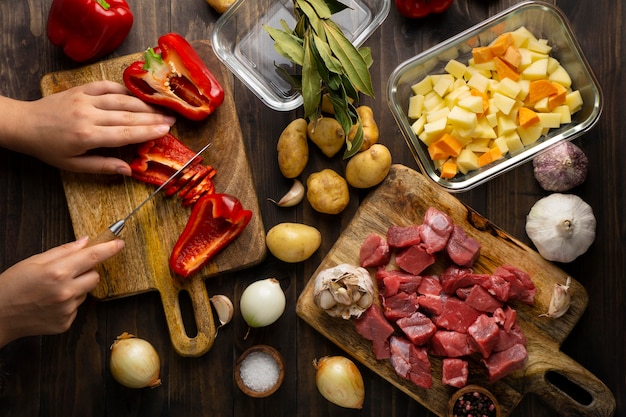The Convection Oven: A Game Changer (but with a Twist)

I’ll admit, I was a bit skeptical about convection ovens at first. Why mess with a good thing, right? But then I took the plunge, and let me tell you, my mind was blown. Those circulating fans are like a magic wand, whipping up a gust of hot air that cooks your food faster and more evenly than a traditional oven. You get crispy skin, juicy meat, and a whole lot less waiting around.
Now, where’s the twist? Convection ovens are fantastic for most dishes, but they can be a bit tricky with a turkey. The faster cooking time means you need to adjust your temperatures and times to avoid ending up with a dry, overcooked bird. I’ve learned this the hard way – once I forgot to adjust the cooking time, and my turkey turned into a crispy-skinned disaster, still raw on the inside! It was a culinary nightmare!
Understanding Convection oven cooking times

The key to conquering convection oven turkey is understanding how those fans affect cooking times. It's not just about turning down the temperature – it's about knowing how much to adjust the time too. Think of it like this: you’re basically speed-cooking your turkey, so you need to dial back the heat and the time to ensure it cooks perfectly.
Decoding the Convection Oven Temperature Chart
Here’s a quick guide to help you grasp the temperature adjustments:
| Traditional Oven | Convection Oven |
|---|---|
| 450°F (232°C) | 400°F (204°C) |
| 350°F (177°C) | 325°F (163°C) |
As you can see, convection ovens generally require a lower temperature. But that’s not the only factor! You can also expect your cooking times to be reduced by around 15-25%. However, this is just a starting point. The actual cooking time will vary depending on the size and weight of your turkey.
Estimating Cooking Times: Beyond the Basics
Just knowing the temperature adjustment isn’t enough. You need to take into account other factors like the turkey’s weight and whether you're stuffing it.
- Weight Matters: The weight of your turkey is a major factor in determining cooking time. A heavier bird will obviously take longer than a smaller one.
- Stuffing: If you're stuffing your turkey, you'll need to add a bit of extra cooking time to ensure the stuffing reaches the proper temperature. Remember, the stuffing cooks within the turkey, so it takes a bit longer to reach safety levels.
- meat thermometer: Your ultimate weapon is a meat thermometer. It's the most reliable way to check if your turkey is cooked through. This little tool will help you avoid overcooked, dry turkey.
Conquering the Convection Oven Turkey: A Step-by-Step Guide

Armed with the knowledge of convection oven cooking, let's get down to business and roast that turkey! Here’s a step-by-step guide to lead you through the process:
Preparing the Turkey
Before you start, give your turkey a good pat down with paper towels, both inside and out. This will help the skin crisp up beautifully. Now, rub it with olive oil or melted butter – the more, the merrier! This will give your turkey a lovely golden-brown color and add a touch of flavor.
Next, it's time to season generously. Salt and pepper are essential, of course, but don't shy away from adding some herbs and spices. My go-to combination is rosemary, thyme, and sage – it adds a beautiful depth of flavour.
If you're stuffing your turkey, make sure you do it right before putting it in the oven. This prevents the stuffing from becoming soggy.
Roasting the Turkey
Now, place your turkey in a roasting pan, breast side up. Make sure there's enough space in the oven for the turkey to cook evenly. I always place my turkey on a rack inside the roasting pan. This allows hot air to circulate around the bird, ensuring a perfectly crispy skin.
Preheat your oven to the appropriate temperature for your convection oven. I typically use around 325°F (163°C). Give it at least 15 minutes to heat up thoroughly before putting in the turkey.
Time to calculate your cooking time. Use your turkey’s weight and the convection oven guidelines as a starting point. Remember, you’ll need to adjust the time downwards compared to a traditional oven.
For instance, a 12-pound turkey that would take around 3 hours in a traditional oven might only need 2.5 hours in a convection oven. But don't rely solely on estimations! Use a meat thermometer to check the internal temperature. Insert it into the thickest part of the thigh, making sure it doesn't touch any bone. Your turkey is done when the thermometer reads 165°F (74°C).
Basting and Resting: The Finishing Touches
While the turkey is roasting, you can baste it with pan juices every 30-45 minutes. This helps to keep the turkey moist and adds a delicious flavor. You can also add a cup of water to the roasting pan. This creates steam, helping to prevent the turkey from drying out.
Once the turkey is cooked, let it rest for at least 15-20 minutes before carving. This gives the juices time to redistribute throughout the meat, ensuring a juicy and flavorful turkey. (Part 3)
Troubleshooting: Conquering Common Turkey Challenges
Now, let's tackle those pesky turkey problems that can crop up even with the best intentions.
Dry Turkey: A Common Convection Oven Challenge
Dry turkey is a common issue, especially with convection ovens. But don't despair! Here are some strategies to prevent this:
- Regular Basting: Basting the turkey regularly with pan juices helps keep it moist.
- Add Water: Adding a cup of water to the roasting pan creates steam, which also contributes to moisture.
- Don't Overcook: Remember, convection ovens cook faster, so keep a close eye on the cooking time.
- Foil for the First Part: Covering the turkey with foil for the first part of the cooking time can also help retain moisture.
Burnt Skin: A Sign of Overzealous Heat
If your turkey's skin is getting too dark, cover it with foil for the last part of the cooking time. This will help to prevent it from burning.
Uneven Cooking: Making Sure Your Bird Cooks Consistently
If your turkey isn’t cooking evenly, try adjusting the position of the roasting pan in the oven. Make sure it's not too close to the heat source.
Additional Tips for Convection Oven Success
- Roasting Rack: Using a roasting rack ensures even cooking by allowing air to circulate around the turkey.
- Don't Overcrowd: Give your turkey plenty of space to cook. Don't overcrowd the oven with other dishes.
- Check Regularly: Keep an eye on the turkey throughout the cooking process. This helps ensure it's cooking evenly and prevents overcooking.
Convection Oven Turkey Cooking Times: A Guide for Different Sizes
To give you a clearer picture, here's a handy table that outlines general cooking times for different sized turkeys in a convection oven:
| turkey weight (lbs) | Convection Oven Time (hours) |
|---|---|
| 8-10 lbs | 2-2.5 hours |
| 10-12 lbs | 2.5-3 hours |
| 12-14 lbs | 3-3.5 hours |
| 14-16 lbs | 3.5-4 hours |
| 16-18 lbs | 4-4.5 hours |
Remember, these are guidelines, and the actual cooking time will vary depending on your specific oven and the size of your turkey. Always use a meat thermometer to ensure the turkey is cooked through.(Part 5)
FAQs: Answering Your Convection Oven Turkey Questions
What if my turkey isn't cooked through?
If you're worried that your turkey isn't cooked through, you can cook it for a bit longer. However, check the internal temperature regularly with a meat thermometer. Insert it into the thickest part of the thigh, not touching any bone. The turkey is cooked through when the thermometer reads 165°F (74°C).
Can I use a roasting bag in a convection oven?
While you can use a roasting bag in a convection oven, it's not necessary. Convection ovens already circulate hot air, which helps to keep the turkey moist. But if you prefer using a roasting bag, follow the manufacturer's instructions.
Can I stuff my turkey in a convection oven?
Yes, you can stuff your turkey in a convection oven. However, ensure the stuffing is cooked through. It should reach an internal temperature of 165°F (74°C).
How do I know when my turkey is done?
The best way to determine if your turkey is done is by using a meat thermometer. Insert it into the thickest part of the thigh, not touching any bone. It should read 165°F (74°C). You can also check for doneness by pressing on the turkey’s breast. If it feels firm, it's likely cooked through.
Can I use a convection oven to cook a frozen turkey?
It's not recommended to cook a frozen turkey in a convection oven. It's best to thaw the turkey completely before cooking. You can thaw a turkey in the refrigerator for a few days, or in a cold water bath.(Part 6)
The Triumph of a Perfectly Roasted Turkey: A Celebration of Flavor
So there you have it! Convection oven turkey cooking might seem a bit daunting, but with the right knowledge and a bit of practice, you'll become a turkey roasting pro. That perfectly golden-brown skin, the juicy and flavorful meat – it's all worth the effort. Your family and friends will be singing your praises.
Cooking is all about experimentation. Don't be afraid to try different techniques and adjust cooking times based on your own oven and the size of your turkey.
Above all, enjoy the process! cooking a turkey is a celebration, and it's all about creating a delicious and memorable meal that brings people together. So put on some festive music, grab a glass of wine, and have fun!
Everyone is watching

Perfect Rice Every Time: The Ultimate Guide to Cooking Rice
Cooking TipsAs a self-proclaimed foodie, I've always been a bit obsessed with rice. It's the foundation of countless cuisi...

Ultimate Guide to Cooking the Perfect Thanksgiving Turkey
Cooking TipsThanksgiving. Just the word conjures up images of overflowing tables laden with delicious food, the scent of r...

The Ultimate Guide to Cooking Asparagus: Tips, Techniques, and Recipes
Cooking TipsAsparagus. The mere mention of this spring delicacy conjures up images of vibrant green spears, crisp and burs...

Can You Cook Spaghetti with Gasoline? (The Shocking Truth)
Cooking TipsWe've all seen those crazy internet trends. You know, the ones that make you wonder, "Did someone actually try...

Chorizo and Eggs Recipe: The Ultimate Guide
Cooking TipsRight, let’s talk about chorizo and eggs. You know, that classic Spanish dish that's always a winner. It's th...
